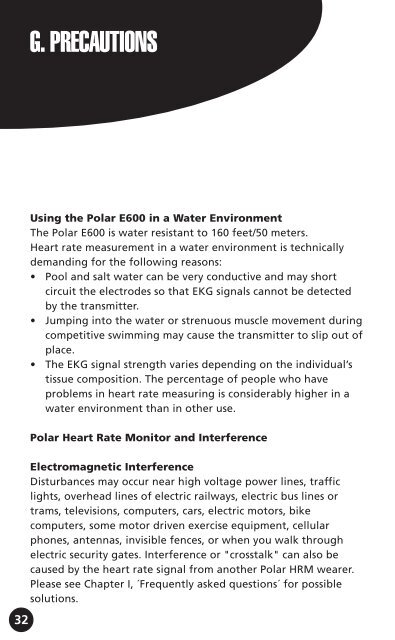HOW TO START THE E600 HEART RATE MONITOR - Polar
HOW TO START THE E600 HEART RATE MONITOR - Polar
HOW TO START THE E600 HEART RATE MONITOR - Polar
You also want an ePaper? Increase the reach of your titles
YUMPU automatically turns print PDFs into web optimized ePapers that Google loves.
32<br />
G. PRECAUTIONS<br />
Using the <strong>Polar</strong> <strong>E600</strong> in a Water Environment<br />
The <strong>Polar</strong> <strong>E600</strong> is water resistant to 160 feet/50 meters.<br />
Heart rate measurement in a water environment is technically<br />
demanding for the following reasons:<br />
• Pool and salt water can be very conductive and may short<br />
circuit the electrodes so that EKG signals cannot be detected<br />
by the transmitter.<br />
• Jumping into the water or strenuous muscle movement during<br />
competitive swimming may cause the transmitter to slip out of<br />
place.<br />
• The EKG signal strength varies depending on the individual’s<br />
tissue composition. The percentage of people who have<br />
problems in heart rate measuring is considerably higher in a<br />
water environment than in other use.<br />
<strong>Polar</strong> Heart Rate Monitor and Interference<br />
Electromagnetic Interference<br />
Disturbances may occur near high voltage power lines, traffic<br />
lights, overhead lines of electric railways, electric bus lines or<br />
trams, televisions, computers, cars, electric motors, bike<br />
computers, some motor driven exercise equipment, cellular<br />
phones, antennas, invisible fences, or when you walk through<br />
electric security gates. Interference or "crosstalk" can also be<br />
caused by the heart rate signal from another <strong>Polar</strong> HRM wearer.<br />
Please see Chapter I, ´Frequently asked questions´ for possible<br />
solutions.

















